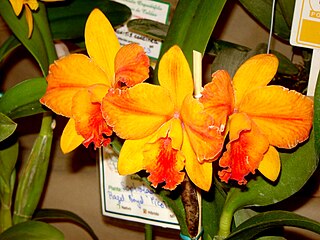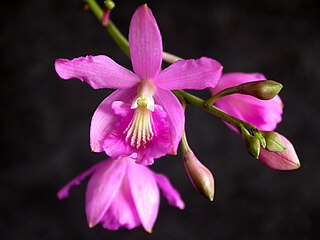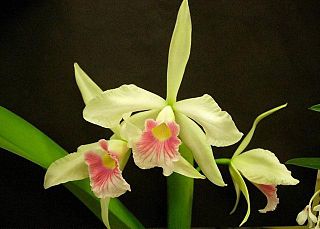
Brassavola is a genus of 21 orchids. They were named in 1813 by the Scottish botanist Robert Brown. The name comes from the Italian nobleman and physician Antonio Musa Brassavola. This genus is abbreviated B. in trade journals.

Cattleya is a genus of orchids from Costa Rica south to Argentina. The genus is abbreviated C in trade journals.

Laelia is a small genus of 25 species in the orchid family (Orchidaceae). Laelia species are found in areas of subtropical or temperate climate in Central and South America, but mostly in Mexico. Laelia is abbreviated L. in the horticultural trade.
Schomburgkia was a genus of plants belonging to the family Orchidaceae. This genus was named for Richard Schomburgk, a German botanist who explored British Guiana during the 19th century. Former species of this genus were either epiphytic or lithophytic in their growth habit. According to the Royal Horticultural Society Schom. was the official abbreviation for this genus.

Prosthechea is a genus of flowering plants in the orchid family (Orchidaceae). The name is derived from the Greek word prostheke (appendix), referring to the appendage on the back of the column. Appendage orchid is a common name for this genus. Prosthechea is abbreviated Psh. in the horticultural trade.

Leptotes, abbreviated Lpt in horticultural trade, is a genus of orchids formed by nine small species that grow in the dry jungles of south and southeast Brazil, and also in Paraguay or Argentina. They are small epiphytic plants of caespitose growth that sometimes resemble little Brassavola, as they share the same type of thin terete leaves, though they are more closely related to Loefgrenianthus.

Laeliocattleya is a nothogenus of intergeneric orchid hybrids descended from the parental genera Laelia and Cattleya. It is abbreviated Lc. in the horticultural trade.

× Sophrolaeliocattleya is a nothogenus of artificial intergeneric orchid hybrids. It is abbreviated as Slc. in the horticultural trade. As of 2008, × Sophrolaeliocattleya is defunct, with the genus Sophronitis having been merged into Cattleya.

Laeliinae is a Neotropical subtribe including 40 orchid genera, such as Brassavola, Laelia and Cattleya. The genus Epidendrum is the largest within this subtribe, containing about 1500 species. This is followed by the genus Encyclia, with over 120 species.

Pseudolaelia is a small genus belonging to the orchid family (Orchidaceae), the entire genus endemic to Brazil. The abbreviation used in the horticultural trade is Pdla.

Guarianthe, abbreviated Gur. in the horticultural trade, is a small genus of epiphytic orchids, growing in wet forests in Mexico, Central America, Colombia, Venezuela and Trinidad. It was separated from the bifoliate Cattleyas in 2003, based on phylogenetic studies of nuclear DNA sequence data.

Cattleya purpurata, known in the past as Laelia purpurata and Sophronitis purpurata, is native to Brazil where it is very popular among orchid growers. It is an epiphyte that is found in the canopy of tall trees near coastal areas, in the Brazilian states of Rio Grande do Sul, Santa Catarina and São Paulo. The orchid favors bright light and cool to warm conditions and is relative easy to cultive. C. purpurata has been used extensively as a parent in hybridizing with Cattleyas. Cattleya purpurata blooms from late spring to fall with three to five flowers on a spike. The flowers are long-lasting and fragrant.

Isabelia is an orchid genus formed by three tiny species and one natural hybrid, spread from the Northeast of Brazil to Argentina, which are closely related to the genus Constantia. During more than a century Isabelia was a genus formed by just one species, however, around 1968, it was merged with genus Neolauchea, also unispecific. In 2001, a third genus was added to it, Sophronitella. The genus name is abbreviated Isa. in cultivation.

Loefgrenianthus blanche-amesiae is a showy orchid species, inhabitant of Serra do Mar mountains in Brazilian southeast. It is the only species of the monotypic genus Loefgrenianthus. It can be differentiated from its closest genus, Leptotes, both because of its pending vegetation with flat leaves and the flowers which have a saccate labellum. Loefgrenianthus blanche-amesiae is highly appreciated by orchid collectors.

Cattleya cernua, commonly known as the nodding sophronitis, is a species of orchid occurring from Brazil to northeastern Argentina. It was the type species of the genus Sophronitis until the genus was made synonymous with Cattleya. Twenty plants of C. cernua have received a total of 22 AOS awards. The described flowers range from 1.9 cm to 3.2 cm horizontal spread and from 2.0 cm to 3.0 cm vertical spread.

Cattleya bicalhoi, commonly known as Laelia dayana, is a species of orchid endemic to Brazil, from southern Minas Gerais to Rio de Janeiro.

Cattleya hoehnei, commonly known by the synonym Laelia mixta, is a species of orchid endemic to Espírito Santo, Brazil. It has been renamed as Cattleya hoehneiVan den Berg (2008).

Cattleya reginae, often known as Laelia reginae or Sophronitis reginae, is a species of orchid endemic to the Serra da Caraça mountains in the state of Minas Gerais of Brazil.
Cássio van den Berg is a Brazilian botanist, noted for work in orchid classification and evolution, especially great changes in the generic circumscriptions of ornamental orchids in the genus Cattleya, based on DNA studies for the subtribe Laeliinae.

Cattleya × elegans is a hybrid orchid in the subtribe Laeliinae. It is a pseudobulb epiphyte. Its formula hybridae is Cattleya purpurata Van den Berg (2008) × Cattleya tigrina A.Rich. (1848). It is found in South and South-East Brazil.


















